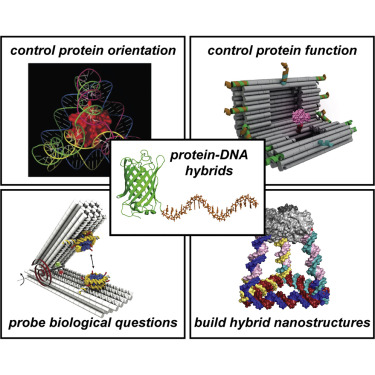Chem ( IF 23.5 ) Pub Date : 2020-02-13 , DOI: 10.1016/j.chempr.2020.01.012 Nicholas Stephanopoulos

|
Proteins and DNA are two commonly used molecules for self-assembling nanotechnology. In this tutorial review, we discuss the hybrid field of “protein-DNA nanotechnology,” whereby proteins are integrated with DNA scaffolds for the creation of hybrid nanostructures with distinct properties of each molecular type. We first discuss bioconjugation strategies, both covalent and supramolecular, for integrating proteins with DNA nanostructures. Next, we review seminal work in four emerging areas of protein-DNA nanotechnology: (1) controlling protein orientation on DNA nanoscaffolds, (2) controlling protein function with DNA nanodevices, (3) answering biological questions with protein-DNA nanostructures, and (4) building hybrid structures that integrate both protein and DNA structural units. Finally, we close with a series of forward-looking research propositions and ideas for directions of the field. The emphasis of this work is on integrated nanostructures with precise protein orientation on DNA scaffolds, as well as hybrid assemblies that integrate the structural and functional properties of each molecule.
中文翻译:

蛋白质和DNA自组装的杂化纳米结构
蛋白质和DNA是用于自组装纳米技术的两个常用分子。在本教程中,我们讨论了“蛋白质-DNA纳米技术”的杂交领域,其中蛋白质与DNA支架整合在一起,以创建具有每种分子类型不同特性的杂交纳米结构。我们首先讨论将蛋白质与DNA纳米结构整合在一起的共价和超分子生物共轭策略。接下来,我们回顾蛋白质-DNA纳米技术的四个新兴领域的开创性工作:(1)控制DNA纳米支架上的蛋白质取向;(2)使用DNA纳米装置控制蛋白质功能;(3)用蛋白质-DNA纳米结构回答生物学问题;以及( 4)建立整合蛋白质和DNA结构单元的杂化结构。最后,我们以一系列针对该领域方向的前瞻性研究命题和构想作为结尾。这项工作的重点是在DNA支架上具有精确蛋白质取向的整合纳米结构,以及整合每个分子的结构和功能特性的杂化装配体。


























 京公网安备 11010802027423号
京公网安备 11010802027423号